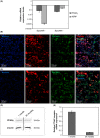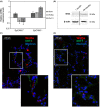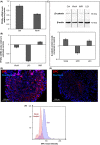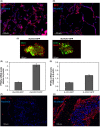Alteration in the Wnt microenvironment directly regulates molecular events leading to pulmonary senescence
- PMID: 24981738
- PMCID: PMC4331750
- DOI: 10.1111/acel.12240
Alteration in the Wnt microenvironment directly regulates molecular events leading to pulmonary senescence
Abstract
In the aging lung, the lung capacity decreases even in the absence of diseases. The progenitor cells of the distal lung, the alveolar type II cells (ATII), are essential for the repair of the gas-exchange surface. Surfactant protein production and survival of ATII cells are supported by lipofibroblasts that are peroxisome proliferator-activated receptor gamma (PPARγ)-dependent special cell type of the pulmonary tissue. PPARγ levels are directly regulated by Wnt molecules; therefore, changes in the Wnt microenvironment have close control over maintenance of the distal lung. The pulmonary aging process is associated with airspace enlargement, decrease in the distal epithelial cell compartment and infiltration of inflammatory cells. qRT-PCR analysis of purified epithelial and nonepithelial cells revealed that lipofibroblast differentiation marker parathyroid hormone-related protein receptor (PTHrPR) and PPARγ are reduced and that PPARγ reduction is regulated by Wnt4 via a β-catenin-dependent mechanism. Using a human in vitro 3D lung tissue model, a link was established between increased PPARγ and pro-surfactant protein C (pro-SPC) expression in pulmonary epithelial cells. In the senile lung, both Wnt4 and Wnt5a levels increase and both Wnt-s increase myofibroblast-like differentiation. Alteration of the Wnt microenvironment plays a significant role in pulmonary aging. Diminished lipo- and increased myofibroblast-like differentiation are directly regulated by specific Wnt-s, which process also controls surfactant production and pulmonary repair mechanisms.
Keywords: Wnt microenvironment; molecular biology of aging; pulmonary senescence.
© 2014 The Authors. Aging Cell published by the Anatomical Society and John Wiley & Sons Ltd.
Figures






Similar articles
-
Chronic WNT/β-catenin signaling induces cellular senescence in lung epithelial cells.Cell Signal. 2020 Jun;70:109588. doi: 10.1016/j.cellsig.2020.109588. Epub 2020 Feb 26. Cell Signal. 2020. PMID: 32109549 Free PMC article.
-
Wnt4 and LAP2alpha as pacemakers of thymic epithelial senescence.PLoS One. 2010 May 18;5(5):e10701. doi: 10.1371/journal.pone.0010701. PLoS One. 2010. PMID: 20502698 Free PMC article.
-
Reduced Frizzled Receptor 4 Expression Prevents WNT/β-Catenin-driven Alveolar Lung Repair in Chronic Obstructive Pulmonary Disease.Am J Respir Crit Care Med. 2017 Jul 15;196(2):172-185. doi: 10.1164/rccm.201605-0904OC. Am J Respir Crit Care Med. 2017. PMID: 28245136
-
Crosstalk Between Peroxisome Proliferator-Activated Receptor Gamma and the Canonical WNT/β-Catenin Pathway in Chronic Inflammation and Oxidative Stress During Carcinogenesis.Front Immunol. 2018 Apr 13;9:745. doi: 10.3389/fimmu.2018.00745. eCollection 2018. Front Immunol. 2018. PMID: 29706964 Free PMC article. Review.
-
PPARγ and Wnt Signaling in Adipogenic and Osteogenic Differentiation of Mesenchymal Stem Cells.Curr Stem Cell Res Ther. 2016;11(3):216-25. doi: 10.2174/1574888x10666150519093429. Curr Stem Cell Res Ther. 2016. PMID: 25986621 Review.
Cited by
-
Protective Effect of Ginsenoside Rg1 on Hematopoietic Stem/Progenitor Cells through Attenuating Oxidative Stress and the Wnt/β-Catenin Signaling Pathway in a Mouse Model of d-Galactose-induced Aging.Int J Mol Sci. 2016 Jun 9;17(6):849. doi: 10.3390/ijms17060849. Int J Mol Sci. 2016. PMID: 27294914 Free PMC article.
-
Cigarette Smoke-Induced Pulmonary Inflammation Becomes Systemic by Circulating Extracellular Vesicles Containing Wnt5a and Inflammatory Cytokines.Front Immunol. 2018 Jul 25;9:1724. doi: 10.3389/fimmu.2018.01724. eCollection 2018. Front Immunol. 2018. PMID: 30090106 Free PMC article.
-
Noncanonical Wnt5a signaling regulates tendon stem/progenitor cells senescence.Stem Cell Res Ther. 2021 Oct 18;12(1):544. doi: 10.1186/s13287-021-02605-1. Stem Cell Res Ther. 2021. PMID: 34663475 Free PMC article.
-
Increased Wnt5a in squamous cell lung carcinoma inhibits endothelial cell motility.BMC Cancer. 2016 Nov 23;16(1):915. doi: 10.1186/s12885-016-2943-4. BMC Cancer. 2016. PMID: 27876017 Free PMC article.
-
Mechanisms and markers of lung ageing in health and disease.Eur Respir Rev. 2025 Jul 23;34(177):240233. doi: 10.1183/16000617.0233-2024. Print 2025 Jul. Eur Respir Rev. 2025. PMID: 40701639 Free PMC article. Review.
References
-
- Balogh P, Bebök Z, Németh P. Cellular enzyme-linked immunocircle assay. A rapid assay of hybridomas produced against cell surface antigens. J. Immunol. Methods. 1992;153:141–149. - PubMed
-
- Bartis D, Csongei V, Weich A, Kiss E, Barko S, Kovacs T, Avdicevic M, D’Souza VK, Rapp J, Kvell K, Jakab L, Nyitrai M, Molnar TF, Thickett DR, Laszlo T, Pongracz JE. Down-regulation of canonical and up-regulation of non-canonical Wnt signalling in the carcinogenic process of squamous cell lung carcinoma. PLoS ONE. 2013;8:e57393. - PMC - PubMed
-
- Bovia F, Salmon P, Matthes T, Kvell K, Nguyen TH, Werner-Favre C, Barnet M, Nagy M, Leuba F, Arrighi JF, Piguet V, Trono D, Zubler RH. Efficient transduction of primary human B lymphocytes and nondividing myeloma B cells with HIV-1-derived lentiviral vectors. Blood. 2003;101:1727–1733. - PubMed
Publication types
MeSH terms
Substances
LinkOut - more resources
Full Text Sources
Other Literature Sources
Research Materials

